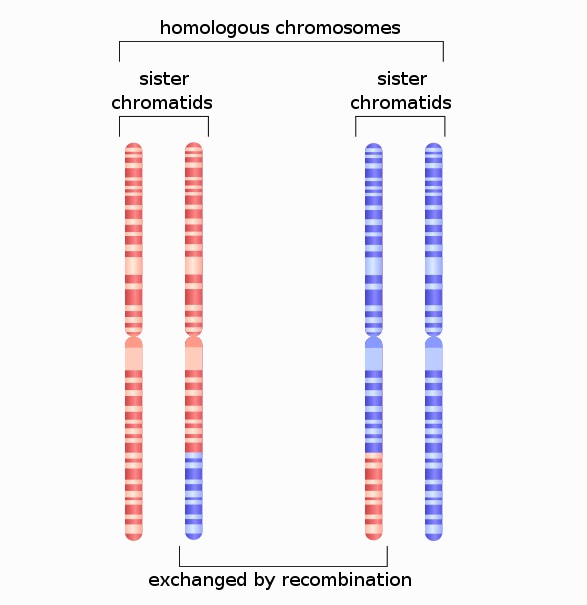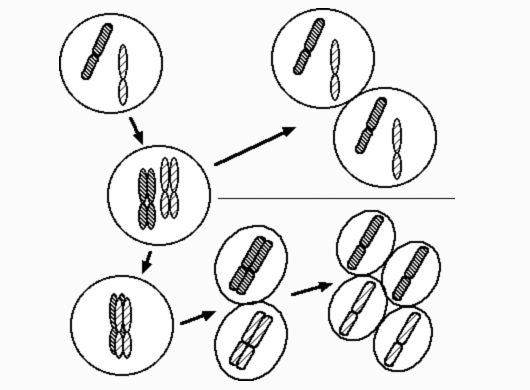Homologous Chromosomes Definition
Homologous chromosomes are two pieces of DNA within a diploid organism which carry the same genes, one from each parental source.
In simpler terms, both of your parents provide a complete genome. Each parent provides the same 23 chromosomes, which encode the same genes. So, our cells carry 46 total chromosomes, in two copies. However, each homologous chromosome can provide a different version of each gene. Two versions of each gene create more variety, lower the detrimental effects of negative mutations, and generally stabilize a population.
Homologous Chromosome Function
Two Versions of Each Gene
Diploid organisms, like humans, carry two copies of the genome in each one of their cells. Having two copies of each chromosome, called homologous chromosomes, helps increase both the variety and stability of a species. While each homologous chromosome carries the same genes, they can carry different versions of the gene. Different versions of a gene are called alleles.
This means that your cells will typically produce 2 versions of every protein encoded by the DNA. Some versions will work better than others. Further, the combination of good and bad proteins produces different phenotypic effects that increase the variety within a population. Some alleles have a dominant/recessive relationship, in which the dominant gene is the only one that shows. Others have more complex relationships, and different combinations of alleles can produce vastly different effects on an organism. This is important because variety helps populations survive in the face of environmental changes.
Homologous Recombination
Lastly, homologous chromosomes take part in a process known as homologous recombination during the formation of gametes. This process is also known as “crossing over”, because parts of the homologous chromosomes are exchanged when they come into close contact. The chromosomes contain the same genes, which are generally the same length and size. These sections can easily be transferred between chromosomes. The image below shows recombination:

In this image, each chromosome has already been replicated in preparation for meiosis. However, two of the chromatids have exchanged genetic material. This process is extremely important for the creation and maintenance of variety within a population. For instance, if red is the paternal chromosome and blue is maternal, the genes they carry will no longer be linked. Just because your father had blue eyes and black hair does not mean you will automatically inherit these traits. Homologous recombination ensures that traits are randomly mixed together, from both parental sources.
Homologous Chromosome Examples
In a Simple Organism
The image below shows a simple organism. This organism is diploid, but only has a 1 pair of chromosomes. These are homologous chromosomes, because they carry the same genes. However, they can carry different alleles of each gene, shown by their internal pattern. This organism can reproduce asexually, simply by duplicating the DNA and dividing the cell. In this case, the organism remains haploid. This is shown in the top portion of the diagram.

The bottom portion of the image shows the production of gametes for sexual reproduction. Meiosis is the process used to create gametes. Meiosis creates haploid cells, which can be combined with gametes from another organism to form a new diploid organism. Haploid organisms have only one copy of the DNA, therefore, they do not have homologous chromosomes. When these gametes pair up and join together, they will again be in the same cell with a new homologous pair.
In Humans
As with the simple hypothetical organism above, humans also have homologous chromosomes. One half of each pair comes from our mother, while the other comes from our father. These chromosomes are carried in the haploid gamete cells, sperm and eggs. When a sperm meets an egg, fertilization occurs and a diploid organism is formed. This zygote, like the organism above, will divide many times to create all of the cells of our body. Each cell in your body, then, contains 23 pairs of homologous chromosomes, or 46 total chromosomes. The image below shows a human karyotype, or visualization of the condensed chromosomes. Notice how each pair has a similar shape and dye pattern. This is because each of these homologous chromosomes carries the same genes.

As we become sexually mature, the human body starts to produce and release gametes. These gametes have been reduced to haploid cells, after first being mixed up and recombined in different arrangements. This means that children will have a mixture of traits not necessarily seen in their parents or grandparents. In fact, some combinations of traits will be completely new thanks to homologous chromosomes and how they help us reproduce.
